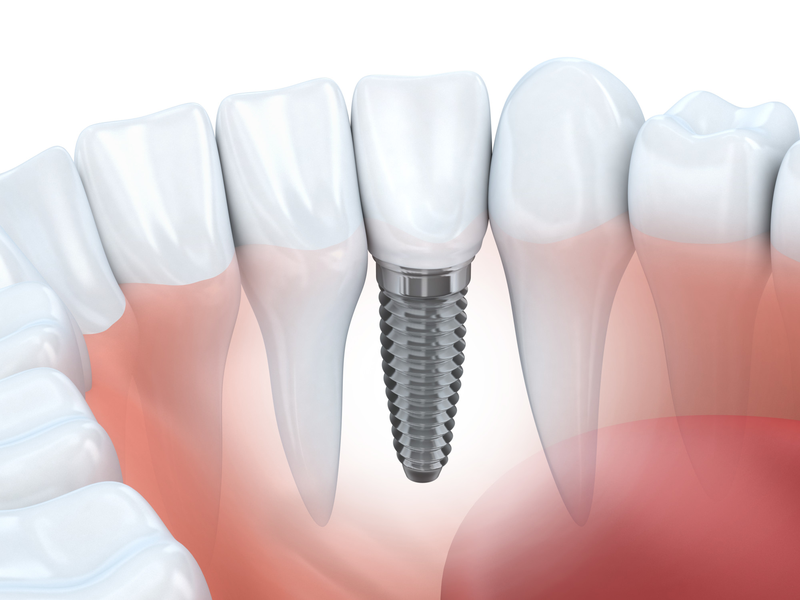When is Dental Implant Recommended & How does it affect ones health

There are many dental procedures that exist today. These all serve a single purpose – to ensure our dental health while attempting to save each and every tooth as much as possible. That said, saving a tooth it is not always a viable option. There are instances when there is no other choice, but to pull out a tooth. When this happens, a dental implant serves to take this missing tooth’s place.
Invented in the 1950s, dental implant surgery has come a long way. Many people now see this dental procedure as the gold standard when it comes to prosthetic replacement. For those who are unaware, a dental implant – a screw-like post, often of titanium material – fills the space left by a once-healthy tooth. This implant, which goes deep into the jawbone, is where a new artificial tooth attaches itself. As months pass, the jawbone heals and fuses itself with the implant. This process is known as osseointegration. Eventually, with the implant mimicking the behavior of a real tooth, we can continue living normally, using our mouth and teeth just like before.
Dental Implant Surgery: A Look at the Process
Depending on one’s jawbone, dental and/or medical history, as well as the type of implant, the surgical procedure may vary from person to person. However, it is important to note that getting a dental implant involves a number of procedures and can last for months. Listed below are the usual step-by-step procedures should you decide to get a dental implant.
- Anesthesia is given to the patient.
- An incision is made in the gums, wherein the optimum point of insertion has been decided upon.
- The site for where the implant is supposed to go is prepared through the use of different-sized drills befitting of the goals.
- The implant is screwed into place, according to the necessary depth.
- A cap is placed on top of the implant channel.
- The site is cleaned and sanitized to ensure that the wound does not get infected.
- The gums are stitched over and the healing process begins.
- Oftentimes, a healing abutment is placed to avoid a second surgery.
It seems like a quick process, but the timeline between the procedures involved in getting an implant depends on your situation. The healing process, for example, can take around three to four months and will involve some waiting.
On Recommendations that Matter: When Do You Need to Get a Dental Implant?
We cannot deny that there is a lot of apprehension in getting a surgical procedure such as this. If not for financial reasons, some people have an innate fear of dentists. It is of utmost importance, however, to listen to our doctors’ advice. If you disagree, feel free to seek a second opinion elsewhere. Our doctor, naturally, should be looking out for our best interests as well. As mentioned earlier, the primary goal of dentistry is to be less invasive as possible, and to save our original teeth. So, when would it make sense for your dentist to recommend getting a dental implant?
- You have one (or more) missing teeth that needs to be replaced in order to restore functionality or aesthetics.
- You want to improve your speech, as being toothless or having gaps between our teeth, can affect the way we talk and communicate.
- You have a fully grown jawbone and your oral tissues are healthy; but you don’t want to wear dentures.
These are just a few reasons for a dental implant. Of course, it is a solution to improving one’s quality of life, especially when one is already toothless. Imagine the hassle of using dentures, as opposed to having a set of artificial teeth that can last you a lifetime. After all, is it not true that our teeth is an essential part of the body that we rely on every day? From eating to talking, as well as feeling confident about ourselves, dental implants can go a long way in making our lives better.
The Recovery and Moving Forward
After the procedure, you can expect some level of discomfort, specifically, when the anesthetic wears off. Your doctor will be prescribing some painkillers and antibiotics, which you can take whenever you feel any of the following symptoms post-surgery:
- Swollen gums and face
- Bruised gums and/or face
- Sharp pains at the site of the implant
- Non-stop bleeding
There is nothing to worry, as your normal activities will resume in less than or around 24 hours. Surely, once your implant has healed, you will be thankful that you pursued getting a dental implant. With the technological advancements that most clinics have today, the success rate of dental implants is at 98 percent. The ease in living without a worry about crumbling teeth and having a confident, beaming smile is quite the dream. But at the end of the day, this is your decision to make. Move forward in life with healthy teeth and a healthy outlook; stay positive!




